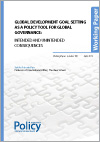
The Future of Global Poverty in a Multi-Speed World: New Estimates of Scale, Location and Cost
Resumo:Various recent papers have sought to make projections about the scale and locations of global poverty in the next 20 to 30 years. Such forecasts have significant policy implications because they are used to inform debates on the scale and objectives of future aid. However, these papers have produced some very different projections for global poverty so that a complex and rather inconsistent picture has emerged. Estimating even current global poverty levels is problematic for a range of reasons arising largely from the limitations of available data and the various alternative modeling approaches used to compensate for them. Forecasts for future poverty become further complicated by the range of scenarios for future economic growth and changes in inequality. Largely as a result of these differences, not only do different analysts arrive at very different understandings of the extent and prospects for global poverty but it is also extremely difficult to make meaningful comparisons between different analyses. (…)
Esta publicação também pode ser encontrada em um formato condensado e/ou expandido: